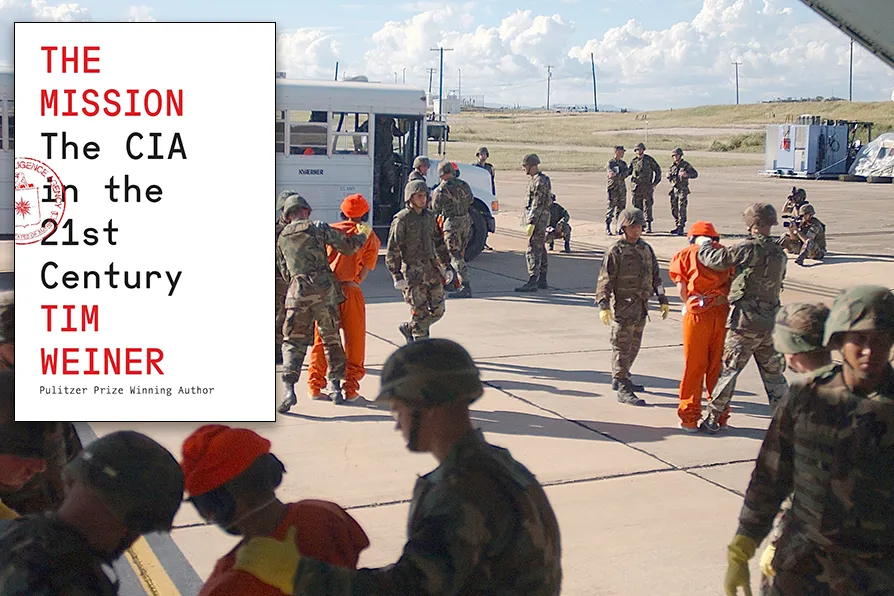GEOFF BOTTOMS appreciates the local touch brought to a production of Dickens’s perennial classic
GUILLERMO THOMAS enjoys a survey of the current state of the CIA (aka Langley) from an expert and insider of sorts

 SHAMELESS DISPLAY OF COERCION: Previously unreleased photos of Guantanamo captives, 2002, brought to Guantanamo Bay from Afghanistan by way of Incirlik, Turkey. [Pic: Staff Sergeant Jeremy Lock/CC]
SHAMELESS DISPLAY OF COERCION: Previously unreleased photos of Guantanamo captives, 2002, brought to Guantanamo Bay from Afghanistan by way of Incirlik, Turkey. [Pic: Staff Sergeant Jeremy Lock/CC]
The Mission: The CIA in the 21st Century
Tim Weiner, William Collins, £10.99
THIS is the second book by Pulitzer-winning Tim Weiner on the CIA. Legacy of Ashes: The History of the CIA covered its founding in 1947 through the cold war and into the early 2000s. A foreign and subsequently national security correspondent at the New York Times, Weiner was rather critical of the CIA in this work. It won the National Book Award, became a widely cited critique, and sparked backlash from the intelligence “community.”
The Mission: The CIA in the 21st Century, picks up post-September 11 2001, covering Langley’s operations in Afghanistan, Iraq, cyberwarfare and its role in Ukraine and counterterrorism. It is notably more favourable.
The book is based on interviews with six former CIA directors, 13 station chiefs and scores of undercover officers who had never spoken to a journalist before. These included the architect of the CIA’s secret prison system, a woman who dismantled a global nuclear smuggling ring, a deep-cover spy who had recruited presidents and the sitting chief of the CIA’s clandestine service.
Perhaps that access came with a price tag. Maybe Weiner was actively sought out — just the man to help improve the CIA’s public image in the US after the revelations and roasting it received for its actions in Iraq and Afghanistan, from secret black sites, drone strikes to “enhanced interrogation techniques” including waterboarding, sleep deprivation, stress positions and rectal feeding.
Weiner isn’t a fan of the CIA as paramilitary force post-September 11. But he is pleased with more recent work, disrupting nuclear smuggling networks, penetrating the Kremlin and aiding Nato on Ukraine: “With the dimunition of the war on terror, the agency has slowly returned to its original purpose of espionage,” Wiener says, although he perhaps overplays the CIA’s intelligence/paramilitary force dichotomy.
Covert action has continued alongside intelligence-gathering barely uninterrupted during the CIA’s near 80-year history, including in Ukraine, where from 2014 it not only built Kiev’s spy services into the “best sources of intelligence against the Russians” but it trained Ukrainian special forces.
The book attempts to show how this is not a case of rogue behaviour. “Every president since Truman had commanded the CIA to intervene with guns and money to control the fate of nations, when sending in the marines was not an option. Its officers did what they were ordered to do. They were executing the foreign policy of the United States,” he writes, paraphrasing Richard Helms’s words to him.
This is as true for spy work as covert action. We read how president George W Bush demanded the evidence to fit his case for war on Iraq. Powell told the UN the intel on Saddam’s WMD was backed up by “solid sources” when in fact the strongest part of the intel constituted “unverified intelligence from an unvetted and unquestioned source.”
Doing the president’s bidding is a real concern in the era of Donald Trump. The current resident of the White House is “among the CIA’s greatest challenges,” “an authoritarian leader who presents the clearest danger to national security of the United States since this century began.”
Since his first presidency, Trump has seen the CIA as part of a deep state conspiracy against him, and his apparent admiration and sympathy for Vladimir Putin has made him deeply suspect to much of the US Establishment. The author argues: “A new cold war is slowing escalating toward existential danger… but even the best intelligence will not sway a leader who will not heed it.”
His concerns may be overblown. As we learned in his first term, Trump is fickle; he is now deploying the CIA against Nicolas Maduro’s Venezuela, and the love-in with Putin has cooled.
It is clear from the book that Weiner believes the US is a force for good in the world; China and Russia are the baddies. He quotes Woodrow Wilson that “the world must be safe for democracy. Its peace must be planted upon the tested foundations of political liberty.” This is also the “credo for the CIA,” writes Weiner.
We know instead that Washington and Langley have consistently done the opposite, nurturing and supporting dictators and crushing democracy across the globe, from Iran in 1953 to Chile in 1973 and beyond. Weiner observes that “my enemies’ enemy is my friend” is a central tactic of the CIA. This is how the brutal regimes of theocratic Iran, Saddam’s Iraq and Bashar al-Assad’s Syria were at different times allies and enemies. He also observes that democracy has been on the retreat across the world and that there is now an autocrat in the White House. But he can’t see the obvious connections.
This is a Hollywood take on the CIA. Nevertheless, it is a good read from an expert in the field and insider of sorts.

SOLOMON HUGHES highlights a 1995 Sunday Times story about the disappearance of ‘defecting Iraqi nuclear scientist.’ Even though the story was debunked, it was widely repeated across the mainstream press, creating the false – and deadly – narrative of Iraqi WMD that eventually led to war












